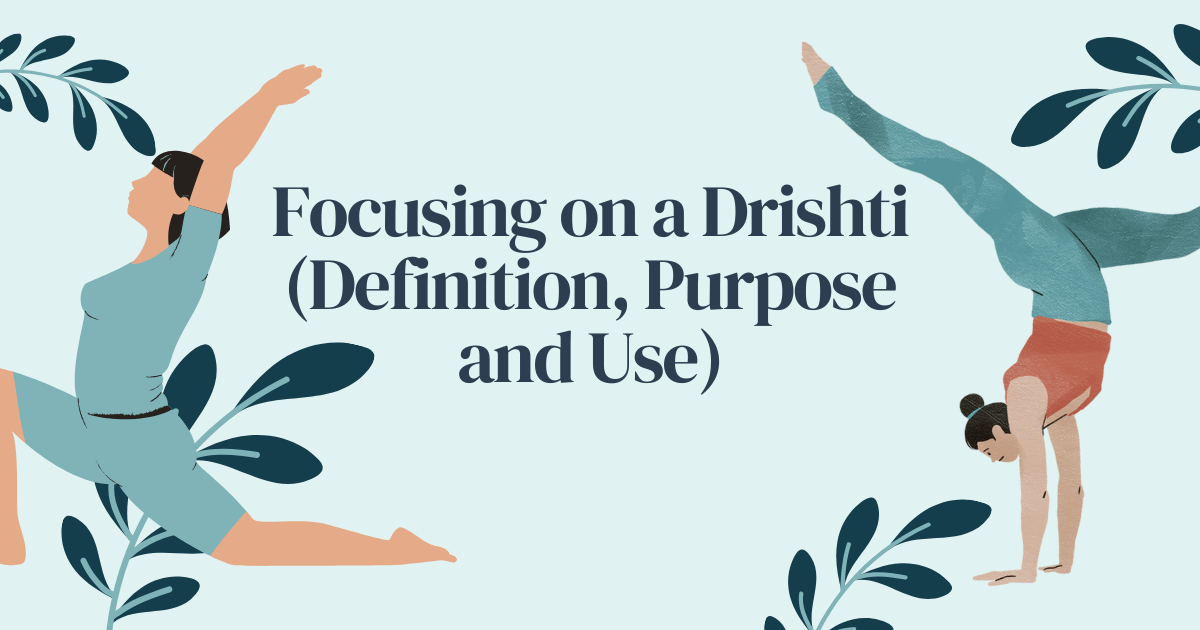We’ve all had moments in our yoga practice where our attention drifts and our eyes start wandering around the room. While letting your gaze roam isn’t harmful, it doesn’t help sharpen mental focus or concentration. Yoga teachings highlight a clear link between a scattered gaze and a distracted mind. To counter the eyes’ naturally restless and stimulating tendencies, yoga offers a solution: the drishti, or focal point. By fixing your gaze on one spot, you can cultivate deep concentration, refine alignment, boost awareness, and transform your asana practice into a dynamic moving meditation.
What is a drishti?
The Sanskrit term drishti is often translated as “view,” “gaze,” or “point of focus.” It’s a specific spot—either external or internal—where you direct your eyes or inner vision, commonly used during meditation or while holding a yoga pose. Ancient yogis observed that our attention naturally follows our eyes, and the quality of our gaze directly influences the quality of our thoughts.
There are two main types of focal points:
- Bahya drishti: An external gazing point used in physically oriented yoga practices.
- Antara drishti: An internal gazing point used in meditative practices to encourage pratyahara (sensory withdrawal).
The purpose of using a drishti
When your eyes settle on a single point, the mind stops being pulled in by external distractions. And when that focus turns inward, awareness deepens, shielding the mind from outside disturbances. This practice helps the mind sharpen into deep concentration. Over time, consistently using a drishti builds dharana (yogic concentration) and ekagraha (single-pointed focus)—key techniques for calming the mind and entering meditative states.
In yoga poses, a focal point guides and refines movement and alignment. It acts as an anchor, letting the rest of the body follow smoothly.
During meditation, a drishti helps steady the mind. Common points include the breath (diaphragm), the third eye, or external objects like the nose tip, a candle, a yantra, or a mandala.
How to use a drishti
In yoga postures, a drishti deepens the pose’s primary movement while keeping the mind engaged. To use it, simply pick the spot where your eyes naturally land based on the posture’s alignment.
Developing drishti in yoga takes time. First, focus on nailing the pose’s alignment, then the breath, and finally the gaze. A focal point is especially useful in long holds or balancing poses. As you fix your eyes on your chosen spot, let your mental focus merge with it. Allow your spine’s movement to follow your gaze.
The 9 drishtis
In Ashtanga and other yoga traditions, nine specific drishtis are used:
- Nasagrai Drishti: Gaze at the nose tip (e.g., Upward-Facing Dog, Chaturanga).
- Angusta Ma Dyai Drishti: Gaze at the thumbs (e.g., Warrior I, Chair).
- Pahayoragrai Drishti: Gaze at the toes (e.g., Hand to Toe pose, seated forward bends).
- Nabi Chakra Drishti: Gaze at the navel (e.g., Downward-Facing Dog).
- Hastagrai Drishti: Gaze at the hands (e.g., Triangle, Warrior II).
- Parsva Drishti (left): Gaze left (e.g., seated twists).
- Parsva Drishti (right): Gaze right.
- Urdhva Drishti: Gaze upward (e.g., Balancing Half-Moon, Prayer Twist).
- Naitrayohmadya/Broomadhya Drishti: Gaze at the third eye (e.g., Fish, Reverse Warrior II).
Drishti in Ashtanga Yoga
Yoga teacher Kino MacGregor explains the nine traditional focal points in this 2-minute video, showing how they train the mind to ignore external distractions. Watch it below:
Other focal points
Memorizing these points isn’t essential—experimenting with your gaze matters more. Generally, direct your eyes toward the pose’s stretch or movement. Like modifying poses for injuries, you might adjust the drishti. The key is locking attention, not the spot.
For inward-focused practices, try concentrating on one of the seven chakras. Pranayama or mantra yoga might use the nose tip or diaphragm. Yoga nidra uses over 60 focus points, including body parts like the thumb, wrist, or heel.
Tips for using a drishti
- Keep your eyes relaxed—no straining.
- Use bahya (external) drishti in active practices and antara (internal) in meditation.
- Closing your eyes during poses can deepen inward focus.
In bhakti yoga, drishti shifts to a loving gaze toward the divine. Broadly, it’s about cultivating the right perspective in life. Adapting your view to life’s changes helps avoid attachments that cause suffering.
When your mind wanders, gently return to your focal point. Each time you refocus, you strengthen concentration. Like a muscle, mental focus grows with practice.
